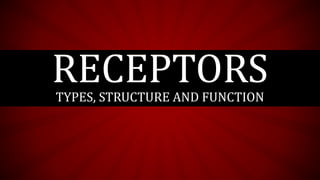
receptors-.pdf
- 1. RECEPTORS TYPES, STRUCTURE AND FUNCTION
- 3. • A (globular) protein that receives chemical signal • Plasma membrane or Nucleus • Bound by a ligand • Specific cellular-biochemical pathway • Cellular or tissue response INTRODUCTION
- 4. THE ROLE OF THE RECEPTOR •Binding site •Intermolecular bonds •Induced fit of the receptor protein •Change in receptor shape •Domino effect •Chemical signal being •Chemical messenger departs unchanged
- 5. THE BINDING SITE Cell Membrane Cell Receptor Messenger message Induced fit Cell Receptor Messenger Message Cell Messenger Receptor
- 6. THE BINDING • Binding site is nearly complementary to the messenger • Binding alters the shape of the receptor (induced fit) • Altered receptor shape leads to further effects - signal transduction
- 7. BINDING ENERGY Intermolecular bonds are not optimum length for maximum binding strength After –Intermolecular bond lengths optimised Phe Ser O H Asp CO2 Induced Fit Phe Ser O H Asp CO2
- 8. INDUCED FIT • Binding interactions must be strong enough to hold the messenger sufficiently long for signal transduction to take place • Interactions must be weak enough to allow the messenger to depart • Implies a fine balance • Designing molecules with stronger binding interactions results in drugs that block the binding site - antagonists
- 9. MAIN TYPES OF RECEPTORS • Ion channel receptors • G-protein-coupled receptors • Kinase-linked receptors • Intracellular receptors
- 10. ION CHANNEL RECEPTORS • Receptor protein is part of an ion channel protein complex • Receptor binds a messenger leading to an induced fit • Ion channel is opened or closed • Ion channels are specific for specific ions (Na+, Ca2+, Cl-, K+) • Ions flow across cell membrane down concentration gradient • Polarises or depolarises nerve membranes • Activates or deactivates enzyme catalysed reactions within cell
- 12. ION CHANNEL RECEPTORS • Transmembrane Proteins • TM2 of each protein subunit ‘lines’ the central pore TM4 TM4 TM4 TM3 TM3 TM3 TM3 TM3 TM2 TM2 TM2 TM2 TM2 TM1 TM1 TM1 TM1 TM1 TM4 TM4
- 13. GATING • Chemical messenger binds to receptor binding site • Induced fit results in further conformational changes • TM2 segments rotate to open central pore Closed Transverse view TM2 TM2 TM2 TM2 TM2 Cell membrane TM2 TM2 Open Transverse view TM2 TM2 TM2 TM2 TM2
- 14. GATING • Fast response measured in milli-seconds • Ideal for transmission between nerves • Binding of messenger leads directly to ion flows across cell membrane • Ion flow = secondary effect (signal transduction) • Ion concentration within cell alters • Leads to variation in cell chemistry
- 18. LIGAND BINDING SITE A. Monoamines: pocket in TM helices B. Peptide hormones: top of TM helices + extracellular loops + N-terminal chain C. Hormones: extracellular loops + N-terminal chain D. Glutamate: N-terminal chain
- 19. TYROSINE KINASE - LINKED RECEPTORS • Bifunctional receptor / enzyme • Activated by hormones • Overexpression (Cancer)
- 20. TYROSINE KINASE - LINKED RECEPTORS • Protein serves dual role - receptor plus enzyme • Receptor binds messenger leading to an induced fit • Protein changes shape and opens active site • Reaction catalyzed within cell • Overexpression related to several cancers
- 21. TYROSINE KINASE - LINKED RECEPTORS
- 22. TYROSINE KINASE - LINKED RECEPTORS
- 23. EPIDERMAL GROWTH FACTOR RECEPTOR (EGFR)
- 24. EPIDERMAL GROWTH FACTOR RECEPTOR (EGFR) • Active site on one half of dimer catalyzes phosphorylation of Tyr residues on other half • Dimerization of receptor is crucial • Phosphorylated regions act as binding sites for further enzymes • Results in activation of signaling proteins and enzymes • Message carried into cell
- 25. INSULIN RECEPTOR (TETRAMERIC COMPLEX)
- 27. INTRACELLULAR RECEPTORS • Chemical messengers must cross cell membrane • Chemical messengers must be hydrophobic • Example-steroids and • Steroid receptors
- 30. THANK YOU